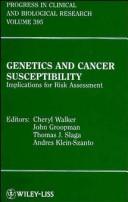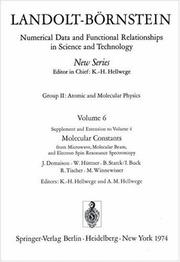| Listing 1 - 10 of 147 | << page >> |
Sort by
|
Book
ISBN: 1412367948 Year: 2009 Publisher: Chicoutimi : J.-M. Tremblay,
Abstract | Keywords | Export | Availability | Bookmark
 Loading...
Loading...Choose an application
- Reference Manager
- EndNote
- RefWorks (Direct export to RefWorks)
Book
ISBN: 1786202581 Year: 2015 Publisher: London : The Geological Society,
Abstract | Keywords | Export | Availability | Bookmark
 Loading...
Loading...Choose an application
- Reference Manager
- EndNote
- RefWorks (Direct export to RefWorks)
Magnetic susceptibility (MS) is a tool frequently used by geologists on sediments or rocks to perform correlations and sea-level or climatic reconstructions. Applied measurements are made on unoriented, bulk samples and bulk MS is mostly influenced by the magnetic mineral content of the rock and often interpreted as influenced by detrital inputs. Magnetic data acquisition is fast and straightforward and this allows the high-resolution sampling needed for palaeoclimatic research (e.g. spectral analysis). However, the link with detrital inputs is not always preserved and the impact of diagenesis on the final MS signal can blur primary information. This volume includes contributions dealing with the origin of the magnetic minerals, and the application of MS as a palaeoenvironmental or palaeoclimatic proxy and also as a tool to provide astronomical calibration in order to improve the chronology of selected time intervals.
Book
ISBN: 3662664607 3662664593 Year: 2023 Publisher: Berlin, Heidelberg : Springer Berlin Heidelberg : Imprint: Springer,
Abstract | Keywords | Export | Availability | Bookmark
 Loading...
Loading...Choose an application
- Reference Manager
- EndNote
- RefWorks (Direct export to RefWorks)
With the objective to collate the enormous amount of information on magnetic susceptibility parameters of a very large number of a variety of skeletons and present it in a form that can readily be retrieved and used, a new pattern is being introduced with the present volume keeping in view that now a majority of research groups look at the scientific data electronically. In this volume, magnetic properties of complexes of ???(La, Ti, V, Cr, Mo, Mn, Re, Fe, Ru, Os, Co, Rh, Ni, Pd, Pt, Cu, Au, Ce, Pr, Nd, Sm, Gd, Tb, Ho, Yb)??? are described. All the magnetic properties of each individual substance are listed as a single document which is self-explainable and allowing search in respect of substance name, synonyms, common vocabulary, and even structure.
Magnetic susceptibility. --- Magnetism. --- Mathematical physics --- Physics --- Electricity --- Magnetics --- Susceptibility, Magnetic
Book
Year: 2016 Publisher: Frontiers Media SA
Abstract | Keywords | Export | Availability | Bookmark
 Loading...
Loading...Choose an application
- Reference Manager
- EndNote
- RefWorks (Direct export to RefWorks)
Phytopathogenic bacteria of the Xanthomonas genus cause severe diseases on hundreds of host plants, including economically important crops, such as bean, cabbage, cassava, citrus, hemp, pepper, rice, sugarcane, tomato or wheat. Diseases occurring in nature comprise bacterial blight, canker, necrosis, rot, scald, spot, streak or wilt. Xanthomonas spp. are distributed worldwide and pathogenic and nonpathogenic strains are essentially found in association to plants. Some phytopathogenic strains are emergent or re-emergent and, consequently, dramatically impact agriculture, economy and food safety. During the last decades, massive efforts were undertaken to decipher Xanthomonas biology. So far, more than one hundred complete or draft genomes from diverse Xanthomonas species have been sequenced (http://www.xanthomonas.org), thus providing powerful tools to study genetic determinants triggering pathogenicity and adaptation to plant habitats. Xanthomonas spp. employ an arsenal of virulence factors to invade its host, including extracellular polysaccharides, plant cell wall-degrading enzymes, adhesins and secreted effectors. In most xanthomonads, type III secretion (T3S) system and secreted effectors (T3Es) are essential to bacterial pathogenicity through the inhibition of plant immunity or the induction of plant susceptibility (S) genes, as reported for Transcription Activation-Like (TAL) effectors. Yet, toxins can also be major virulence determinants in some xanthomonads while nonpathogenic Xanthomonas species do live in sympatry with plant without any T3S systems nor T3Es. In a context of ever increasing international commercial exchanges and modifications of the climate, monitoring and regulating pathogens spread is of crucial importance for food security. A deep knowledge of the genomic diversity of Xanthomonas spp. is required for scientists to properly identify strains, to help preventing future disease outbreaks and to achieve knowledge-informed sustainable disease resistance in crops. This Research Topic published in the ‘Plant Biotic Interactions’ section of Frontiers in Plant Science and Frontiers in Microbiology aims at illustrating several of the recent achievements of the Xanthomonas community. We collected twelve manuscripts dealing with comparative genomics or T3E repertoires, including five focusing on TAL effectors which we hope will contribute to advance research on plant pathogenic bacteria.
Resistance --- susceptibility --- Xop --- Type III effector --- Immunity

ISBN: 0471137774 Year: 1996 Publisher: New York, NY : Wiley-Liss,
Abstract | Keywords | Export | Availability | Bookmark
 Loading...
Loading...Choose an application
- Reference Manager
- EndNote
- RefWorks (Direct export to RefWorks)
NEOPLASMS --- DISEASE SUSCEPTIBILITY --- RISK ASSESSMENT --- CARCINOGENS --- GENETICS

ISBN: 0306441977 1489923810 1489923799 Year: 1991 Publisher: New York London Plenum Press
Abstract | Keywords | Export | Availability | Bookmark
 Loading...
Loading...Choose an application
- Reference Manager
- EndNote
- RefWorks (Direct export to RefWorks)
Book
ISBN: 3662624656 3662624664 Year: 2021 Publisher: Berlin, Germany : Springer,
Abstract | Keywords | Export | Availability | Bookmark
 Loading...
Loading...Choose an application
- Reference Manager
- EndNote
- RefWorks (Direct export to RefWorks)
Magnetic materials. --- Paramagnetism. --- Magnetic susceptibility. --- Susceptibility, Magnetic --- Magnetism --- Nuclear magnetic resonance --- Nuclear moments --- Materials
Book
ISBN: 1107144698 1280449373 9786610449378 0511185421 051118459X 051118722X 051131339X 0511546238 0511186290 Year: 2004 Publisher: Cambridge, UK ; New York, NY, USA : Cambridge University Press,
Abstract | Keywords | Export | Availability | Bookmark
 Loading...
Loading...Choose an application
- Reference Manager
- EndNote
- RefWorks (Direct export to RefWorks)
In the last fifteen years, substantial progress has been made in identifying why some people are particularly susceptible to specific infectious diseases. Extensive evidence has accumulated that host genes are important determinants of the outcome of infection for many common pathogens. This book summarises advances that have been made in understanding the complexity of host genetic susceptibility. The diseases covered include those of great public health importance such as malaria and HIV, and those of topical interest such as Creutzfeldt-Jakob disease. Many different techniques have been used to identify host genes involved in infectious disease susceptibility. Each chapter describes how these discoveries were made and the book is therefore useful to anyone planning genetic studies on a multi-factorial disease, regardless of whether it has an infectious etiology.
Disease susceptibility. --- Infection. --- Host-parasite relationships --- Medical genetics. --- Genetic aspects.

ISBN: 3540059776 0387059776 9783540059776 Year: 1974 Volume: 6 6 Publisher: Berlin: Springer,
Abstract | Keywords | Export | Availability | Bookmark
 Loading...
Loading...Choose an application
- Reference Manager
- EndNote
- RefWorks (Direct export to RefWorks)
Esr (electron spin resonance) --- Magnetic susceptibility --- Microwave spectra --- Molecular beams --- Spin, electronic

ISBN: 3805563477 3318002135 Year: 1997 Publisher: Basel Freiburg Paris : Karger,
Abstract | Keywords | Export | Availability | Bookmark
 Loading...
Loading...Choose an application
- Reference Manager
- EndNote
- RefWorks (Direct export to RefWorks)
Genetic Variation --- Disease Susceptibility --- Diet --- Chronic Disease --- Diet Therapy --- Adverse Effects
| Listing 1 - 10 of 147 | << page >> |
Sort by
|

 Search
Search Feedback
Feedback About UniCat
About UniCat  Help
Help News
News